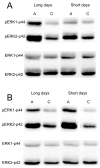Effects of photoperiod and experience on aggressive behavior in female California mice
- PMID: 20060017
- PMCID: PMC2831116
- DOI: 10.1016/j.bbr.2009.12.038
Effects of photoperiod and experience on aggressive behavior in female California mice
Abstract
Aggressive behavior among females is observed in many species, but the mechanisms of this behavior have historically been understudied. In many species of rodents, winter-like short day photoperiods induce increased aggression levels compared to summer-like long day photoperiods. Recent reports in hamsters show that short days also increase aggression in females. We examined the effects of photoperiod on aggression in female California mice, and for the first time compare brain activity of aggression-tested female rodents under different photoperiods. We observed that female California mice were more aggressive when housed in short days versus long days. Intriguingly, we also observed that under long days female attack latency decreases with repeated testing in resident-intruder tests. These data suggest that winner effects that have been described in males may also occur in females. We also used the expression of phosphorylated extracellular signal-regulated kinases (pERK) in the brain to estimate brain activity during aggression tests. pERK can alter neuronal activity in the short term and in the long term can act as a transcription factor. Using immunoblot analyses we observed that aggression-induced pERK expression in the female bed nucleus of the stria terminalis and medial amygdala occurs under both long and short days. Thus, the mechanisms controlling increased aggression under short days are still unclear and additional study is needed.
Copyright 2010 Elsevier B.V. All rights reserved.
Figures






Similar articles
-
Activation of extracellular signal-regulated kinases in social behavior circuits during resident-intruder aggression tests.Neuroscience. 2010 Jan 20;165(2):325-36. doi: 10.1016/j.neuroscience.2009.10.050. Neuroscience. 2010. PMID: 19874872 Free PMC article.
-
Rapid effects of estradiol on male aggression depend on photoperiod in reproductively non-responsive mice.Horm Behav. 2008 Jan;53(1):192-9. doi: 10.1016/j.yhbeh.2007.09.016. Epub 2007 Sep 29. Horm Behav. 2008. PMID: 17976598 Free PMC article.
-
Nongenomic effects of estradiol on aggression under short day photoperiods.Horm Behav. 2013 Aug;64(3):557-65. doi: 10.1016/j.yhbeh.2013.06.002. Epub 2013 Jun 10. Horm Behav. 2013. PMID: 23763907 Free PMC article.
-
Winter madness: Melatonin as a neuroendocrine regulator of seasonal aggression.J Exp Zool A Ecol Integr Physiol. 2022 Dec;337(9-10):873-889. doi: 10.1002/jez.2601. Epub 2022 Apr 22. J Exp Zool A Ecol Integr Physiol. 2022. PMID: 35451566 Free PMC article. Review.
-
Rapid Effects of Estradiol on Aggression in Birds and Mice: The Fast and the Furious.Integr Comp Biol. 2015 Aug;55(2):281-93. doi: 10.1093/icb/icv048. Epub 2015 May 16. Integr Comp Biol. 2015. PMID: 25980562 Free PMC article. Review.
Cited by
-
Inhibition of vasopressin V1a receptors in the medioventral bed nucleus of the stria terminalis has sex- and context-specific anxiogenic effects.Neuropharmacology. 2016 Nov;110(Pt A):59-68. doi: 10.1016/j.neuropharm.2016.07.018. Epub 2016 Jul 21. Neuropharmacology. 2016. PMID: 27452721 Free PMC article.
-
Acute inhibition of kappa opioid receptors before stress blocks depression-like behaviors in California mice.Prog Neuropsychopharmacol Biol Psychiatry. 2018 Aug 30;86:166-174. doi: 10.1016/j.pnpbp.2018.06.001. Epub 2018 Jun 4. Prog Neuropsychopharmacol Biol Psychiatry. 2018. PMID: 29879438 Free PMC article.
-
Importance of sex and trauma context on circulating cytokines and amygdalar GABAergic signaling in a comorbid model of posttraumatic stress and alcohol use disorders.Mol Psychiatry. 2021 Jul;26(7):3093-3107. doi: 10.1038/s41380-020-00920-2. Epub 2020 Oct 21. Mol Psychiatry. 2021. PMID: 33087855 Free PMC article.
-
Sex-specific effects of social defeat stress on miRNA expression in the anterior BNST.Behav Brain Res. 2021 Mar 5;401:113084. doi: 10.1016/j.bbr.2020.113084. Epub 2020 Dec 22. Behav Brain Res. 2021. PMID: 33358922 Free PMC article.
-
Leveraging the unique social organization of California mice to study circuit-specific effects of oxytocin on behavior.Horm Behav. 2024 Apr;160:105487. doi: 10.1016/j.yhbeh.2024.105487. Epub 2024 Jan 27. Horm Behav. 2024. PMID: 38281444 Free PMC article. Review.
References
-
- Abraham IM, Todman MG, Korach KS, Herbison AE. Critical in vivo roles for classical estrogen receptors in rapid estrogen actions on intracellular signaling in mouse brain. Endocrinology. 2004;145:3055–3061. - PubMed
-
- Beaugrand J, Goulet C, Payette D. Outcome of dyadic conflict in male green swordtail fish, Xiphophorus helleri: Effects of body size and prior dominance. Anim Behav. 1991:41.
-
- Becker JB, Arnold AP, Berkley KJ, Blaustein JD, Eckel LA, Hampson E, Herman JP, Marts S, Sadee W, Steiner M, et al. Strategies and Methods for Research on Sex Differences in Brain and Behavior. Endocrinology. 2005;146:1650–1673. - PubMed
-
- Blanchard RJ, Wall PM, Blanchard DC. Problems in the study of rodent aggression. Horm Behav. 2003;44:161–170. - PubMed
-
- Caldwell HK, Albers HE. Effects of photoperiod on vasopressin-induced aggression in Syrian hamsters. Horm Behav. 2004;46:444–449. - PubMed
Publication types
MeSH terms
Substances
Grants and funding
LinkOut - more resources
Full Text Sources

